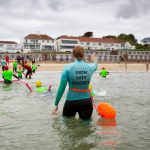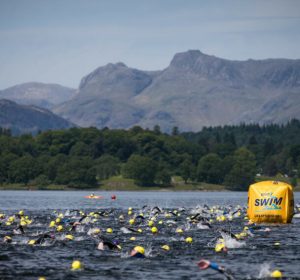Something nasty beneath the surface in the North Channel
Swim coach and occasional H2Open contributor Ed Williams set out to swim the North Channel on 3 September 2014. It was a beautifully calm day but something nasty was lurking beneath the surface. This is his story.
On 3 September 2014 at 5.30 in the morning, I entered the water in Donghadee (Ireland) ready to swim 22 miles to Port Patrick in Scotland. Unfortunately things did not quite go to plan. This is what happened.
The alarm went off at 3.30 although I had barely slept a wink that night due to the nerves of what was about to come. Eighteen months of hard training six days a week had finally come to fruition as I was about to prepare for the hardest swim of my life, the North Channel. The hotel would not provide a breakfast at such an ungodly hour so I loaded up on three pastries and two bowls of instant porridge. I could barely eat as I was so nervous but knew that I had to so forced it down.
We had prepared all of the kit the night before and these were all waiting at the door. Bags full of high carbohydrate drinks, cake, jelly babies and emergency supplies were meticulously measured and planned to aid me over the estimated 12 hour swim. At five, we made our way to the harbour to meet the rest of the crew.
The swim was supposed to haven take place two weeks earlier but was aborted due to bad weather before I even got in the water. Unfortunately, this meant my original crew were unable to join me but luckily my mother stepped in, along with Mark, who had kindly agreed to step in at the last minute. He had selflessly driven through the night to help me. Both did an amazing job through the swim and I could not have got as far as I did without their support.
At 5.15 we were picked up by the boat crew. We boarded and started getting me ready for my journey. I was introduced to the observer from the Irish Long Distance Swimming Association who would monitor the swim and record my every move to make sure I stuck to the rules.
My crew then smeared me in Vaseline to stop me chafing, fixed a glow stick to my goggles to stop me getting lost in the night and made a few last-minute adjustments to the kit. I entered the water and swam to shore as a Channel swim is only valid if it starts and finishes on land. I was expecting the usual pain of the cold as I entered the 13 degree Celsius water but this never came. Perhaps it was the nerves or the sheer joy at finally being able to swim but I was in a good place and the water felt absolutely fine. I touched land and was given the signal to start my swim.
It was pitch black still and all I could see was the light on my support boat as I turned to breathe every few strokes. The conditions were perfect and I was very comfortable. This was awesome and I could not believe my luck as the North Channel is usually very rough. If I had swam the week before it would have been 12 ft waves all the way. Today though was totally calm.
However, within five minutes I felt a nasty jolt of pain on my face and arms. It was like a net of acid covering me which was quickly spreading to every cell of my skin. I had swum straight into my first lion’s mane jellyfish; something which I was about to get uncomfortably familiar with.
I have been stung before but I have always been able to see what hit me. As it was totally dark I had no warning and this was a shock to me. I knew what it was though and just carried on expecting that to be just one of a few.
My feeding plan was to eat every hour for the first two hours then every 30 minutes for the duration of the swim. This was designed to give me a strong start and catch the tide as in the Irish Channel you need to swim fast in order to work with the tides.
When I swam the English Channel in 2006 my bottles of feed were thrown down to me and I would attempt to throw them back. As I am an atrocious thrower (my one year old daughter throws better) I lost several bottles at sea so this time we devised a method of lowering my feeds to me in a basket on a pole. This worked really well as I could simply place my empty bottles back in the basket after each feed. This worked like clockwork and I couldn’t believe how good I was feeling. I had been stung a few more times by this point but thought nothing of it.
The second hour passed and along came the second feed. I drunk some high carb fuel and had a couple of jelly babies, just as I had practiced.
I was swimming at my usual 48 strokes per minute, which is relatively slow (some swimmers will do 75 or 80 strokes per minute). I’ve worked hard to develop a long and graceful stroke which helps me conserve energy and keep me at exactly the two miles per hour pace that I thought would be the best way to cross this channel. However, the boat crew were looking concerned. I could see them talking hurriedly amongst themselves with worried looks and knew there was a problem. I stopped and asked what was up. Apparently I was not swimming fast enough. I was surprised as I think of myself as quite a fast swimmer. The tides however had other ideas and were due to change earlier than we first thought. If I didn’t pick up the pace I would miss the tide change and not make it into Scotland. I know so many swimmers who have got within one mile of their destination never to make it as the tides pushed them backwards faster than they could swim forwards. I didn’t want to be one of those statistics so picked up the pace to something like 2.5 to 3 mph, which I held for the next four hours. Throughout this time I was feeling strong and managing my feeds well. I was however being stung repeatedly every few seconds.
The water stayed calm and the temperature comfortable. But there was a down side. The warmer and the calmer the water the higher the jellyfish stay and in higher numbers. The North Channel is notorious for its population of lion’s mane jellyfish. They are huge red animals with massive tentacles and for the duration of my swim I was constantly banging into them and being stung.
This was not pleasant and was starting to affect me. Each sting was a shot of agony. The jellyfish are so big out there and their tentacles so long that when you swim into them it can take a couple of strokes to get out of their grip. I could feel their tentacles clinging to me and their venom pulsing into me, which was really unnerving as well as agonising.
Six hours into the swim I asked how I was doing and the response was absolutely brilliantly. So well in fact that if I kept this up I could potentially break the world record time of nine and a half hours. This filled me with confidence and I carried on convinced in my mind I would make it.
I was coping with the pain and the cold numbs it considerably but something was starting to feel wrong. I started cramping and feeling sick. This was concerning and not something I had planned for.
Eight hours into the swim we were less than four miles off the coast of Scotland. We could see the detail in the buildings and the light house at Port Patrick. Under normal circumstances I would put my head down and get on with it but something was very wrong. I suddenly lost all power in my stroke and started having uncontrollable muscle spasms. This was not exhaustion as 15 minutes earlier I had felt perfectly fine but something else and it was worrying me. By now I had been stung hundreds of times and it was starting to occur to me that I had taken one sting too many. I turned to take a breath but could get no air in. I went down to exhale and no air came out. It was clear to me that I was going into respiratory failure, which I knew to be a possible reaction to severe jellyfish stings. Things were turning very nasty indeed. In fact, there was a very real risk of imminent death.
On top of the breathing difficulties, I had slowed down so much over the past 15 minutes that I was no longer able to regulate my body temperature, which was now dropping rapidly. It was time to call it a day. I thought about my wife and daughter and knew it wasn’t worth killing myself over a swim and leaving them on their own.
The crew dropped the boat ladder, pulled me out and wrapped me in a space blanket. I then passed out and didn’t wake up again until three hours later when we were back in Ireland. By this time I was extremely sore from jellyfish stings but thankfully the breathing had recovered. I had just dodged a very serious situation and despite my strong desire to carry on and see if I could make the final few miles had decided to put safety first and call it quits.
Despite knowing it was the right decision, I felt (and still do feel) like a failure despite everyone’s comments about how well I did to get so far. When you train so hard to complete a journey nothing prepares you for failing it. The North Channel is famous for its unpredictable conditions and had there been fewer jellyfish I have no doubts I could have made it across. This is so frustrating but I will not leave it there. I have already booked to return next year and will give it another shot.
The North Channel has a reputation of being the hardest of the Oceans Seven but I’m determined to cross it.
Ed Williams runs Elite Swimming Academy in Cambridge. Find out more at www.edwardwilliams.org.uk or on Twitter @edwilliams_swim







